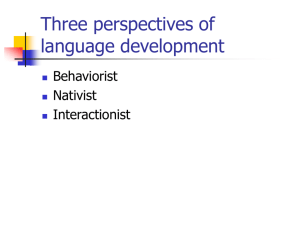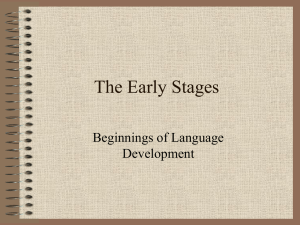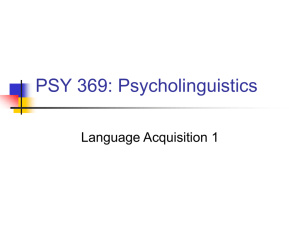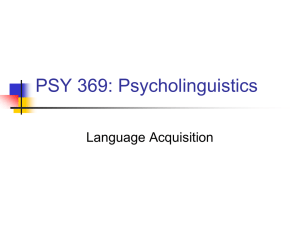phonological development
advertisement
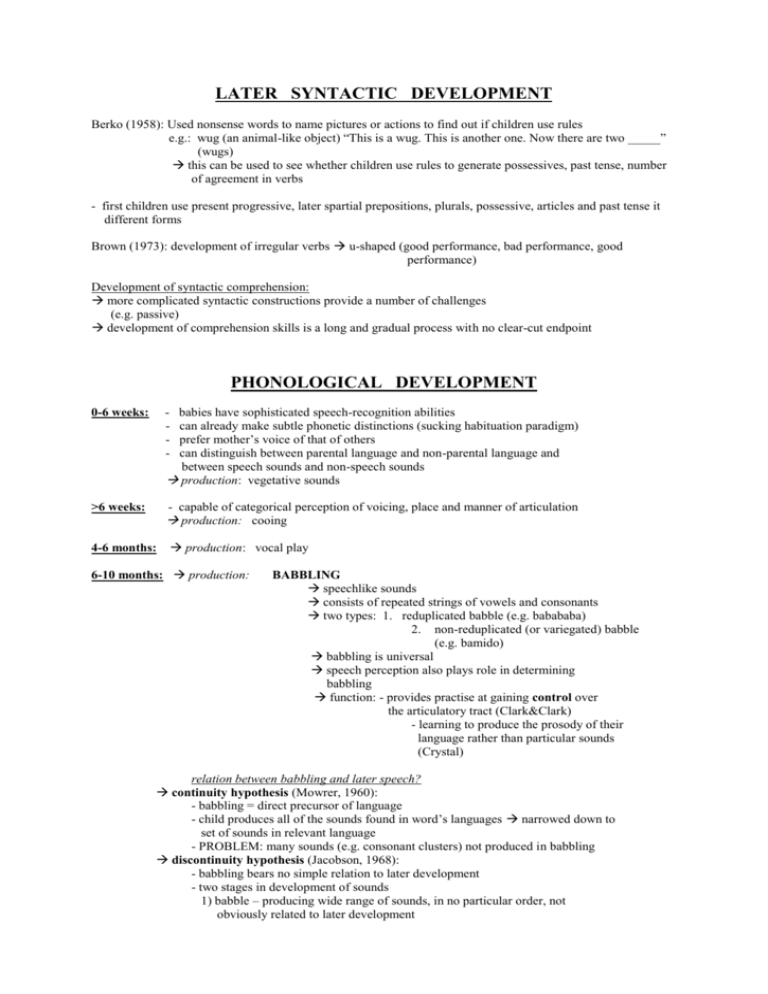
LATER SYNTACTIC DEVELOPMENT Berko (1958): Used nonsense words to name pictures or actions to find out if children use rules e.g.: wug (an animal-like object) “This is a wug. This is another one. Now there are two _____” (wugs) this can be used to see whether children use rules to generate possessives, past tense, number of agreement in verbs - first children use present progressive, later spartial prepositions, plurals, possessive, articles and past tense it different forms Brown (1973): development of irregular verbs u-shaped (good performance, bad performance, good performance) Development of syntactic comprehension: more complicated syntactic constructions provide a number of challenges (e.g. passive) development of comprehension skills is a long and gradual process with no clear-cut endpoint PHONOLOGICAL DEVELOPMENT 0-6 weeks: - babies have sophisticated speech-recognition abilities can already make subtle phonetic distinctions (sucking habituation paradigm) prefer mother’s voice of that of others can distinguish between parental language and non-parental language and between speech sounds and non-speech sounds production: vegetative sounds >6 weeks: - capable of categorical perception of voicing, place and manner of articulation production: cooing 4-6 months: production: vocal play 6-10 months: production: BABBLING speechlike sounds consists of repeated strings of vowels and consonants two types: 1. reduplicated babble (e.g. babababa) 2. non-reduplicated (or variegated) babble (e.g. bamido) babbling is universal speech perception also plays role in determining babbling function: - provides practise at gaining control over the articulatory tract (Clark&Clark) - learning to produce the prosody of their language rather than particular sounds (Crystal) relation between babbling and later speech? continuity hypothesis (Mowrer, 1960): - babbling = direct precursor of language - child produces all of the sounds found in word’s languages narrowed down to set of sounds in relevant language - PROBLEM: many sounds (e.g. consonant clusters) not produced in babbling discontinuity hypothesis (Jacobson, 1968): - babbling bears no simple relation to later development - two stages in development of sounds 1) babble – producing wide range of sounds, in no particular order, not obviously related to later development 2) sudden disappearence of many sounds that were previously in their repertoires - silent period between babbling and early speech but: “protowords” = phonological sequences that are neither clearly babbling nor words early words might be embedded in variegated babble points to some continuity between babbling and early speech 10-18 months: production: single word utterances >18 months: production: two-word utterances >2 years: production: telegraphic speech >2 years, 6 monts: production: full sentences output simplification: - young children simplify words - producing shorter strings - omit final consonant, reduce consonant clusters, omit unstressed syllables, repeat syllables, substitute easier sounds for more difficult sounds SEMANTIC DEVELOPMENT - first words from about 1 year on - in first year new words added slowly, 18-24 months about 50 words around this point: vocabulary explosion - children differ in earliest words; Nelson: 2 groups expressive (emphasize people and feelings) referential children (emphasize objects) - generally: difference between things that can be moved and things that move moving things tend to be named befor movable things - Greenfield&Smith: early words refer to different roles (e.g. “mama” to particular actions carried out by mama) THE EMERGENCE OF WORDS - semantic development depends on conceptual development linguistic development must follow cognitive development - joint attention with adults is an essential component of learning a language - first words emerge out of situations where exemplar of category referred to by word is present in view of adult and child: ostensive model: “look and name” pointing at e.g. dog saying the name child attaches name to object but: MAPPING PROBLEM = child does not know which attribute of input is being labled obviously developing child uses a number of lexical principles to help to establish meaning of new words: CONSTRAINTS ON LEARNING NAMES FOR THINGS, e.g.: 1. Whole object assumption = cognitive system tends to treat ostensive definitions as lables for whole objects 2. Taxonomic constraint = children prefer to use new words to associate things that are taxonomically related ( knows the word “cat” e.g. dog will also be called cat) 3. Mutual exclusivity assumption = each object can only have one lable 4. Novel name-nameless category = children assign words to objects for which they don’t already have names ERRORS IN THE EARLY REPRESENTATION OF MEANING 1) Over-extensions (= over generalizations): child uses word in broader way than adult 2) Under- extension: words are used mor specifically than their meaning LATER DEVELOPMENT OF MEANING - over-extensions stop at around 2 ½ years - children start asking “What’s the name of that?” - vocabulary develops very quickly - semantic complexity: words with simpler semantic representation acquired first (e.g. big-small vs. wide-narrow) - verbs more difficult to acquire than nouns greater reliance on complex linguistic context
